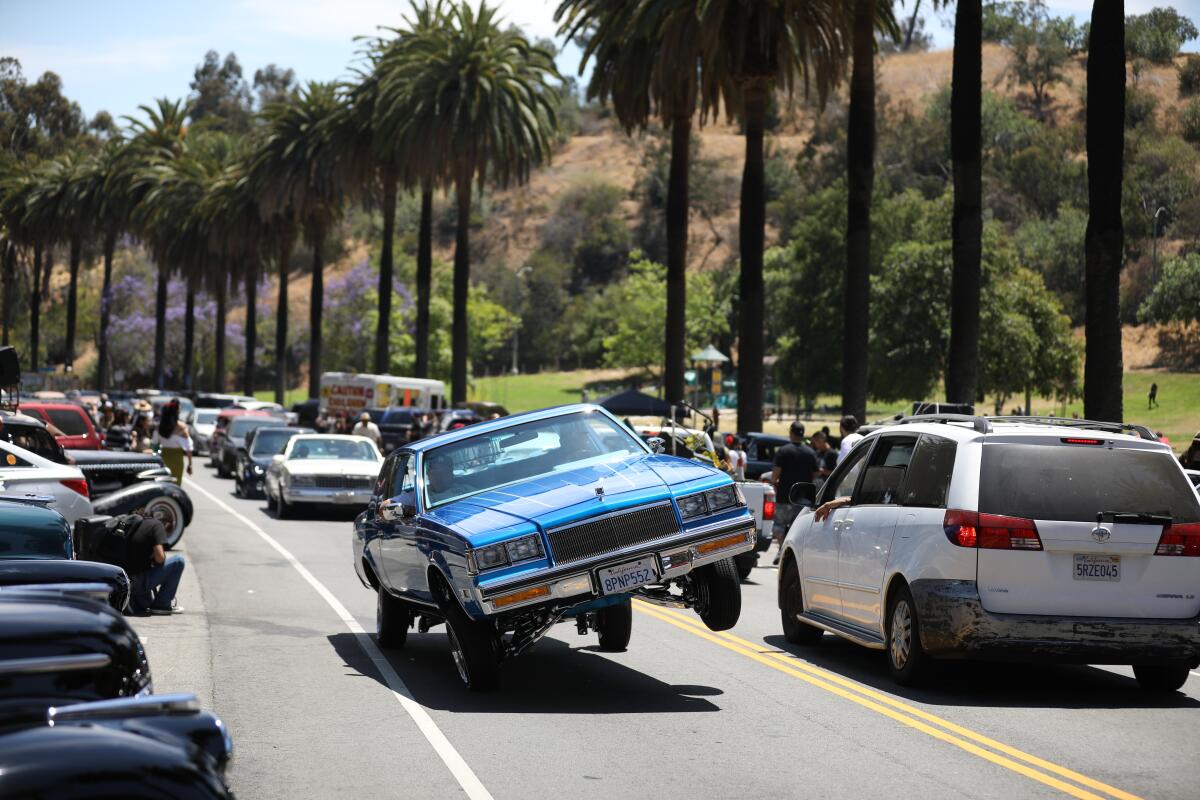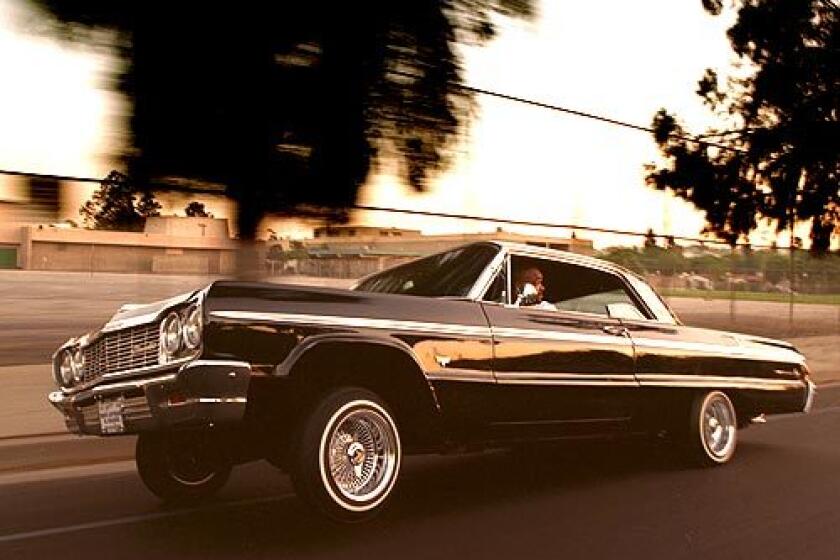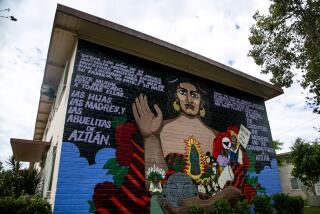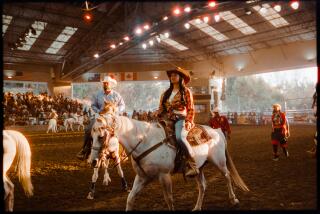Column: Cruising into the mainstream with a lowrider professor

- Share via
Standing in front of about 50 people at Cal State Northridge’s Art Galleries Saturday afternoon, Denise Sandoval fumbled with the mic hanging around her neck and apologized.
“I’m not as cool as Janet Jackson,” the Chicana and Chicano studies professor said. Her curated tour of the show everyone was there to see — a multidisciplinary overview of 15 female artists in the lowrider world — was half an hour late. Some of the artists hadn’t yet shown up.
No one cared. The atmosphere was like a polite house party. To the crowd, Sandoval could do no wrong — because she had never done wrong by them.
Sandoval, who has taught at Cal State Northridge since 2002, is perhaps the premier scholar on lowrider culture and also an exemplar of what an academic should be. She travels to car shows across the country to conduct oral histories and frequently receives emails from students and scholars who want to do their own research. She has helped curate lowrider-themed shows at the Petersen Automotive Museum for a quarter-century, including one that runs through May and features some of the most famous bombs and boats ever crafted.
The Mexican American car culture has been enshrined in pop culture. Now the Petersen Automotive Museum takes a closer look, dispelling stereotypes.
The museum’s director of exhibitions, Bryan Stevens, praised Sandoval for “add[ing] a unique academic viewpoint that elevates our exhibitions and helps make them approachable to those new to the subject matter.” Sandoval’s reputation is such that when the owners of Lowrider Magazine, which shut down in 2019, came back last year for a one-off edition celebrating women cruisers and creators, they asked her to serve as editorial director. The issue, written and photographed and designed entirely by mujeres, sold out within hours.
People from all those threads of Sandoval’s career were at Cal State Northridge to cheer on their champion. There were students and older folks, tough-looking men and wispy chipsters. Among them was Onni, a Wilmington native who was shocked when Sandoval asked in 2017 to showcase some of her artwork at the Petersen.
“I had to read her email again and again when I first got it, because Petersen used to be a date for my husband and I, and I was being asked to be a part of it,” said the 31-year-old. Her pieces are in the current Petersen exhibit, and she painted a portrait of Sandoval for the Cal State Northridge show. “Every time I’m with Denise, I feel like I gotta have a pen and paper, because she drops so much knowledge.”
Also there were sisters Beca Almanza and Pearl “Quata” Elizarraras, who drove in from Riverside in Elizarraras’ ’65 Impala convertible. The two were on the cover of the special-edition Lowrider magazine along with two other middle-aged women, a choice that Sandoval said she insisted on because it would “flip the script” on the cliché of bikini-clad women standing before cars like hood adornments.
“Lowriding is in Denise’s sangre,” said Almanza, holding her Yorkie puppy, Chevy.
Elizarraras agreed: “It’s never about her when she does her thing. It’s always about us.”

Sandoval quickly found her groove after the opening audio flub. She walked the crowd through all the artwork while lecturing in a loud but measured voice on the history of women in lowriding and the challenges they’ve faced.
“Doing this exhibit was sort of a dream,” she said, to nods and smiles. Her gold-colored hoop earrings, which read “I [heart] Lowriders,” gleamed under the gallery lights. “With lowriders, you can create the world that you want to see.”
Manny Velazquez looked on with pride. The Pacoima native, an icon in the San Fernando Valley as a muralist and youth interventionist, has known Sandoval for years.
“When I was going to CSUN [in the 1970s], they saw a brown person like me in the art galleries, they’d suspect me of stealing,” he said. “Now, to walk into the main gallery and see what Denise has done? It’s great — it’s due.”
A few hours before Sandoval’s presentation, we met for breakfast at a Mexican diner in Mission Hills.
Sandoval’s middle-class Mexican American family “only drove normal cars — mostly Pintos,” she joked while picking at her huevos a la Mexicana. But lowriders were never far away while she was growing up in La Puente.
“Every Friday, when I went to school at St. Joseph’s, we’d have to cross Glendora [Avenue] to attend Mass,” said Sandoval, 53. “And when we’d go back to school, we could see guys in their rides at the park next to the school. The nuns would say, ‘Don’t talk to them, don’t look at them,’ but I was just so fascinated by everything — so streamlined, so pressed, so powerful.”
She saved up her allowance while attending Bishop Amat High to buy copies of Lowrider and also of Teen Angels, an influential zine that celebrated Chicano culture. At UC Berkeley in the early 1990s, she found old issues of Lowrider in the university’s archives and was struck by how Chicanas used the letters pages to assert themselves in what’s long been thought of as a macho realm.
Lowrider magazine was once among the bestselling newsstand automotive periodicals in the country. After 42 years, it will cease to print this year.
“Margarita Melville taught me that history shouldn’t just be academic, but in the community,” Sandoval said, referring to the legendary nun-turned-activist-turned-professor. “How art and music and culture are important tools to not just have pride in yourselves but to fuel civil rights.”
Sandoval’s interest was further piqued by how little academic literature she could find on lowriders. And it was sealed for good when she came across a Japanese magazine devoted to the subject at Tower Records.
“I saw all these cats who were dressed like homeboys,” she said, awe still in her voice 30 years later. “That’s when I knew I had to study all of this.”
Returning to Southern California for her master’s at Cal State Northridge and doctorate at Claremont Graduate University, Sandoval eventually connected with the Petersen museum, which invited her to curate its first lowrider exhibit in 2000. It broke attendance records. She credits the museum for funding her research trips to lowrider shows across the country, which allowed her to expand her ideas of what lowriding was.
“I always stuck into my little zone of L.A., because I didn’t want to go elsewhere as an outsider — ‘Um, hi, I’m here to document your community,’” Sandoval deadpanned. “But all that travel is how I learned that even though there’s all these regions, they share a language of pride and respect.”
When journalists call her for quotes, Sandoval debunks stereotypes that have long followed lowriders. She especially pushes back against the idea that only cholos drive them — “From the start, there’s been a family and philanthropic aspect to lowriding” — and insists that chroniclers should depict women as more than just proverbial eye candy. Thankfully, she said, social media has helped.
“Now we have a younger generation that’s asking the older guys how to work on cars, and the older guys are more than happy to [help]. That’s not how it used to be. You have women and young girls saying, ‘I can be a painter, I can work on interiors, I can own my own and do it myself.’ That’s flipping the script, man.”
![A woman wearing gold hoop earrings that read "I [Heart] Lowriders."](https://ca-times.brightspotcdn.com/dims4/default/1b59013/2147483647/strip/true/crop/6000x4000+0+0/resize/1200x800!/quality/75/?url=https%3A%2F%2Fcalifornia-times-brightspot.s3.amazonaws.com%2F1b%2F7b%2Fcf3e6a5541b9b3ea4ec0cb01eec1%2F1493893-me-gustavo-column-lowrider-professor-05-mjc.jpg)
In the fall, Sandoval plans to visit Japan for the first time and check out the lowriding scene that influenced her career choice so long ago. She’s also helping the Smithsonian on a forthcoming exhibit about Chicano photography.
But there’s a big project she still needs to tackle: She doesn’t have her own lowrider.
“I know,” Sandoval admitted with an apologetic head shake. “But I don’t have room for one. I don’t have the time to restore it.”
But a profe can dream.
“It would be great to have a Chevy truck and paint it with all this Chicana history. And then take it to schools to inspire students.”
Sandoval looked at me. “But right now? I just drive a Honda.”
More to Read
Sign up for Essential California
The most important California stories and recommendations in your inbox every morning.
You may occasionally receive promotional content from the Los Angeles Times.












